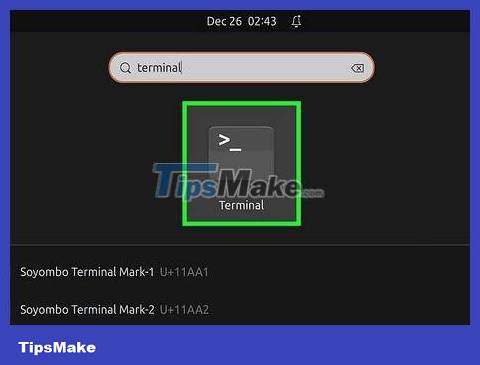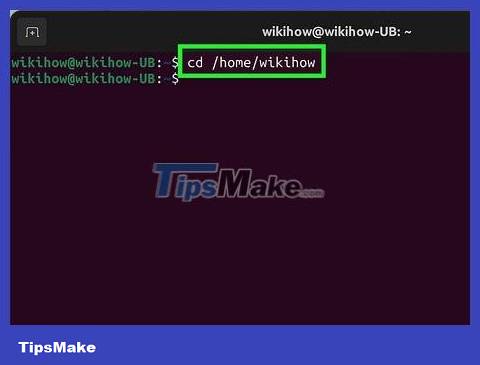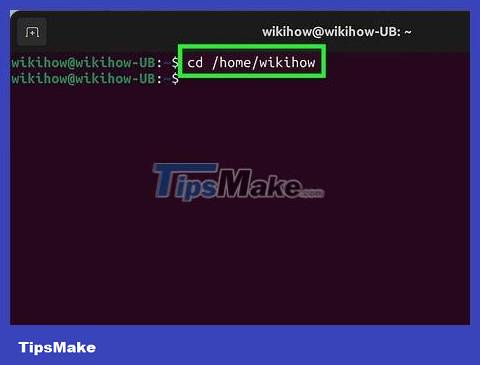How to Create ISO Files on Linux
Create ISO files from multiple files

Collect ISO files into the main directory. Place any files you want to convert into ISO files into a folder inside your home directory .

Open Terminal. Open Menu , then click Terminal to open. The Terminal application is a way for you to access the command line similar to Command Prompt on Windows or Terminal on Mac.
Linux distributions have different arrangements, so you need to find the Terminal application in a certain folder in the Menu section .
You may need to find Terminal on your desktop, or in the toolbar at the top/bottom of the screen.

Enter the "change directory" command. Please type cd /home/username/(replace your username with username ) then press ↵ Enter. Your current directory will be changed to your home directory .
For example, if your username is "potato" then the command to enter is cd /home/potato/.

Enter the command to create an ISO file. Type mkisofs -o destination-filename.iso /home/username/folder-name, making sure to replace "destination-filename" with the name you want to give the ISO file and replace "folder-name" with the name of the folder where the component files are stored.
For example, to create an ISO file named "blueberry" from the files in the "pie" folder, you type mkisofs -o blueberry.iso /home/username/pie.
File and directory names are case-sensitive, so you need to make sure you capitalize what needs to be capitalized.
If you want a multi-word name, add an underscore between the words (for example, "blueberry pie" will become "blueberry_pie").

Press ↵ Enter. The command will execute and create an ISO file including the files located in the selected directory. This ISO file will be in the main directory.
The system may ask you to enter a password before the ISO file is created. Once there, enter your password and press ↵ Enter.
Copy ISO file from CD

Insert the CD-RW disc you want to copy into your computer. You cannot copy an ISO file from a read/write CD (such as an audio CD or movie DVD).

Open Terminal. Open Menu , then click Terminal to open. The Terminal application is a way for you to access the command line similar to Command Prompt on Windows or Terminal on Mac.
Linux distributions have different arrangements, so you need to find the Terminal application in a certain folder in the Menu section .
You may need to find Terminal on your desktop, or in the toolbar at the top/bottom of the screen.

Enter the "change directory" command. Please type cd /home/username/(replace your username with username ) then press ↵ Enter. Your current directory will be changed to your home directory .
For example, if your username is "teresa" then the command to enter is cd /home/teresa/.

Enter the burning command. Type dd if=/dev/cdrom of=/home/username/iso-name.iso, replacing "/dev/cdrom" with the CD location and "iso-name" with the name of the ISO file you want to put.
For example, you need to type of=/home/username/pudding.isoif you want to create an ISO file named "pudding" in your home directory.
If the computer has multiple CD drives, the drives will be numbered from 0 up (for example, the first drive might be named "cd0", the second drive would be "cd1", etc.) .

Press ↵ Enter. As long as the directory of the CD is correct, the computer will create an ISO file from the content on the CD and save it to the main directory.
The system may ask you to enter a password before the ISO file is created. Once there, enter your password and press ↵ Enter.
You should read it
- File Management in Unix / Linux
- How to use pandoc to convert files on Linux
- How to create file swap in Linux
- How to modify and manage Hosts files on Linux
- How to access Linux files on Windows 10
- How to Create and Edit Text Files Using Terminal on Linux
- Manage folders in Unix / Linux
- Is it possible to run .exe files on Linux?
May be interested
- Manage folders in Unix / Linux
 a directory is a file whose only task is to store the name and related file information. all files, which can be regular, special or directory files, are kept in folders.
a directory is a file whose only task is to store the name and related file information. all files, which can be regular, special or directory files, are kept in folders. - Is it possible to run .exe files on Linux?
 you don't need to trade the appeal of windows software for the stability, security, ease of customization (and even great classic appearance) of linux. in this article, you will be shown how to run windows exe (possibly executable) files and software using the linux operating system. these methods can be applied to any linux distribution, including ubuntu, kali linux, centos and many others.
you don't need to trade the appeal of windows software for the stability, security, ease of customization (and even great classic appearance) of linux. in this article, you will be shown how to run windows exe (possibly executable) files and software using the linux operating system. these methods can be applied to any linux distribution, including ubuntu, kali linux, centos and many others. - How to create USB Boot Live Kali Linux
 the most popular and fastest way to apply kali linux is to run it from a usb drive. this method has many advantages. to do this, we first need to create a bootable usb drive from an iso image of kali linux.
the most popular and fastest way to apply kali linux is to run it from a usb drive. this method has many advantages. to do this, we first need to create a bootable usb drive from an iso image of kali linux. - The Cat command in Linux
 the cat command (short for 'concatenate') is one of the most frequently used commands in operating systems like linux / unix. the cat command allows users to create one or more files, view file contents, join files, and redirect output in a terminal or file.
the cat command (short for 'concatenate') is one of the most frequently used commands in operating systems like linux / unix. the cat command allows users to create one or more files, view file contents, join files, and redirect output in a terminal or file. - How to Create an ISO File in Linux
 this wikihow teaches you how to turn a group of files into an iso file on a linux computer. you'll use the linux command line to do this. gather your iso files in the home directory. place any files that you want to turn into an iso file...
this wikihow teaches you how to turn a group of files into an iso file on a linux computer. you'll use the linux command line to do this. gather your iso files in the home directory. place any files that you want to turn into an iso file... - How to Create and Use ISO Files on Linux
 learn how to create, mount, or burn iso images using linux. most linux distributions come with software to create, mount, or burn iso images. using these steps, you will learn to do this, and maybe even understand how it works. create the...
learn how to create, mount, or burn iso images using linux. most linux distributions come with software to create, mount, or burn iso images. using these steps, you will learn to do this, and maybe even understand how it works. create the... - How to create and delete folders in Linux Terminal
 folders are essential for your linux operating system because they contain files you may use often or that the system needs to function correctly.
folders are essential for your linux operating system because they contain files you may use often or that the system needs to function correctly. - How to Find Files in Linux
 if you don't know how, finding files in linux can be quite difficult. here, the best way is to use a few different terminal commands. they are much more powerful than the simple search features on other operating systems, and when you know how to use them well, you will have complete control over your files.
if you don't know how, finding files in linux can be quite difficult. here, the best way is to use a few different terminal commands. they are much more powerful than the simple search features on other operating systems, and when you know how to use them well, you will have complete control over your files. - How to copy and rename files in Linux
 there are more ways to copy and rename files on linux than just cp and mv. try some commands and other ways suggested below.
there are more ways to copy and rename files on linux than just cp and mv. try some commands and other ways suggested below. - How to create an ISO file on Linux
 you may know that an iso file can be burned to a cd / dvd or usb drive, but do you know that you backup or store your files and folders into an iso file? will be better? with an iso file, you can burn it to a cd / dvd as a backup or simply mount it as an external drive and access files from within.
you may know that an iso file can be burned to a cd / dvd or usb drive, but do you know that you backup or store your files and folders into an iso file? will be better? with an iso file, you can burn it to a cd / dvd as a backup or simply mount it as an external drive and access files from within.










 How to Add or Change the Default Port on Linux
How to Add or Change the Default Port on Linux How to Change Time Zone on Linux
How to Change Time Zone on Linux How to Use Wine on Linux
How to Use Wine on Linux How to Ping on Linux
How to Ping on Linux How to Set Up an FTP Server on Ubuntu Linux
How to Set Up an FTP Server on Ubuntu Linux